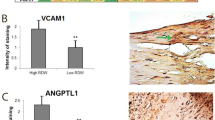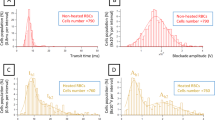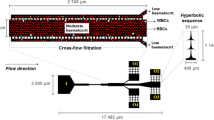Abstract
Because of the rapid development of precision medicine, single-cell analysis has attracted increasing research attention, especially for erythrocyte, whose potential role in the formation of vascular plaque (atherosclerosis) has emphasized the importance of flow characteristics of single erythrocytes in bionic microfluidics. Based on the high incidence of vascular plaques among the elderly and those who have received blood transfusions, we hypothesized that cell membrane hardening changes the fluid adaptability of individual erythrocytes. This hypothesis was verified using an in vitro microfluidic technique based on an analysis of the flow morphology and cell trajectory of individual cells. A symmetrical microchannel was fabricated with a central stenosis to simulate a blood vessel containing plaque. During flowing through this microchannel, normal erythrocyte predominantly exhibited deforming, rotating, and lifting morphologies, resulting in discontinuous contact with the channel wall and a narrower distribution. Conversely, hardened erythrocytes exhibited rolling, swinging, and tumbling morphologies, resulting in stable and continuous contact with the channel wall and a wider distribution. These results indicate that cell membrane hardening decrease cell fluid adaptability on a microscopic scale. This research can offer some new insights into vascular plaques research from a bio-tribological and mechanical perspectives.




Similar content being viewed by others
References
Paramo, J.A., Varea, S., Lecumberri, R.: Thrombosis and antithrombotic therapy in the elderly. Med. Clin. 137, 468–471 (2011)
Murat, B., Semih, C., Naside, G.D., Ronald, W.D., Lars, M.S., Utkan, D.: Integrating cell phone imaging with magnetic levitation (i-LEV) for label-free blood analysis at the point-of-living. Small 12, 1222–1229 (2016)
Yazdani, A., Li, X., Em, K.G.: Dynamic and rheological properties of soft biological cell suspensions. Rheol. Acta. 55, 433–449 (2016)
Litvinov, R.I., Weisel, J.W.: Role of red blood cells in haemostasis and thrombosis. ISBT Sci Ser. 12, 176–183 (2017)
Ariens, R.A.S.: Contribution of red blood cells and clot structure to thrombosis. Blood 126, 23–38 (2015)
Byrnes, J.R., Wolberg, A.S.: Red blood cells in thrombosis. Blood 130, 1795–1799 (2017)
Mackman, N.: The red blood cell death receptor and thrombosis. J. Clin. Investig. 128, 3747–3749 (2018)
Franco, R.S., Estela, M., Puchulu, C., Barber, L.A., Palascak, M.B., Joiner, C.H., Low, P.S., Cohen, R.M.: Changes in the properties of normal human red blood cells during in vivo aging. Am. J. Hematol. 88, 44–51 (2013)
Chen, Y., Feng, Y., Wan, J., Chen, H.: Enhanced separation of aged RBCs by designing channel cross section. Biomicrofluidics 12, 024106 (2018)
Nesbitt, W.S., Westein, E., Tovar-Lopez, F.J., Tolouei, E., Mitchell, A., Fu, J., Carberry, J., Fouras, A., Jackson, S.P.: A shear gradient-dependent platelet aggregation mechanism drives thrombus formation. Nat. Methods 15, 665–673 (2009)
Bacher, C., Schrack, L., Gekle, S.: Clustering of microscopic particles in constricted blood flow. Phys. Rev. Fluids 2, 013102 (2017)
Ha, H., Lee, S.J.: Hemodynamic features and platelet aggregation in a stenosed microchannel. Microvasc. Res. 90, 96–105 (2013)
Myungjin, K., Ho, S.J., Kyung, C.K.: In-vitro investigation of RBCs’ flow characteristics and hemodynamic feature through a microchannel with a micro-stenosis. Int. J. Biol. Biomed. Eng. 1, 1–8 (2008)
Chen, H., Zhang, P., Zhang, L., Liu, H., Jiang, Y., Zhang, D., Han, Z., Jiang, L.: Continuous directional water transport on the peristome surface of Nepenthes alata. Nature 532, 85–89 (2016)
Chen, H., Ran, T., Gan, Y., Zhou, J., Zhang, Y., Zhang, L., Zhang, D., Jiang, L.: Ultrafast water harvesting and transport in hierarchical microchannels. Nat. Mater. 17, 935–942 (2018)
Mancuso, J.E., Ristenpart, W.D.: Stretching of red blood cells at high strain rates. Phys. Rev. Fluids 2, 101101 (2017)
Zeng, N.F., Ristenpart, W.D.: Mechanical response of red blood cells entering a constriction. Biomicrofluidics 8, 064123 (2014)
Abkarian, M., Faivre, M., Viallat, A.: Swinging of red blood cells under shear flow. Phys. Rev. Lett. 98, 188302 (2007)
Doddi, S.K., Bagchi, P.: Three-dimensional computational modeling of multiple deformable cells flowing in microvessels. Phys. Rev. E 79, 046318 (2009)
Dupire, J., Socol, M., Viallat, A.: Full dynamics of a red blood cell in shear flow. Proc. Natl. Acad. Sci. 109, 20808–20813 (2012)
Zhang, X.B., Wu, Z.Q., Wang, K., Zhu, J., Xu, J.J., Xia, X.H., Chen, H.Y.: Gravitational sedimentation induced blood de lamination for continuous plasma separation on a microfluidics chip. Anal. Chem. 84, 780–3786 (2012)
Chen, Y., Li, Y., Li, D., Li, J., Chen, H.: Margination mechanism of hardened red blood cell in microchannel with different cross-section shapes. Microfluid. Nanofluid. 23, 1–10 (2019)
Abkarian, M., Viallat, A.: Dynamics of vesicles in a wall-bounded shear flow. Biophys. J. 89, 1055–1066 (2005)
Chen, Y., Li, D., Li, Y., Wan, J., Li, J., Chen, H.: Margination of hardened red blood cells regulated by vessel geometry. Sci. Rep. 7, 15253 (2017)
Rao, D.S., Goldin, J.G., Fishbein, M.C.: Determinants of plaque instability in atherosclerotic vascular disease. Cardiovasc. Pathol. 14, 285–293 (2005)
Secomb, T.W., Hsu, R., Pries, A.R.: Motion of red blood cells in a capillary with an endothelial surface layer: effect of flow velocity. Am. J. Physiol. Heart Circ. Physiol. 281, H629 (2001)
Forsyth, A.M., Wan, J., Ristenpart, W.D., Stone, H.A.: The dynamic behavior of chemically “hardened” red blood cells in microchannel flows. Microvasc. Res. 80, 37–43 (2010)
Forsyth, A.M., Wan, J., Owrutsky, P.D., Abkarian, M., Stone, H.A.: Multiscale approach to link red blood cell dynamics, shear viscosity, and ATP release. Proc. Natl. Acad. Sci. 108, 10986–10991 (2011)
Tomaiuolo, G., Guido, S.: Start-up shape dynamics of red blood cells in microcapillary flow. Microvasc. Res. 82, 35–41 (2011)
Tomaiuolo, G.: Biomechanical properties of red blood cells in health and disease towards microfluidics. Biomicrofluidics 8, 051501 (2014)
Shelby, J.P., White, J., Ganesan, K., Rathod, K.P., Chiu, T.D.: A microfluidic model for single-cell capillary obstruction by Plasmodiumfalciparum-infected erythrocytes. Proc. Natl. Acad. Sci. 100, 4618–14622 (2003)
Kim, G.Y., Han, J., Park, J.K.: Inertial microfluidics-based cell sorting. BioChip J. 12, 257–267 (2018)
Lee, H., Purdon, A.M., Westervelt, R.M.: Manipulation of biological cells using a microelectromagnet matrix. Appl. Phys. Lett. 85, 1063–1065 (2004)
David, G.G.: A revolution in optical manipulation. Nature 424, 810–816 (2003)
Mcdonald, J.C., Duffy, D.C., Anderson, J.R., Chiu, T.D., Wu, H., Schueller, J.A.O., Whitesides, M.G.: Fabrication of microfluidic systems in poly(dimethylsiloxane). Electrophoresis 21, 27–40 (2000)
Acknowledgements
This work is supported by the National Natural Science Foundation of China (Grants Nos. 51322501, 52005019 and 51420105006), and the Project funded by China Postdoctoral Science Foundation (No. 2019M650419). the National Science Fund for Distinguished Young Scholars (No. 51725501), the National Natural Science Foundation of China (Key Program, No. 51935001), and the National Key R&D Program of China (No. 2019YFB1309702). We thank Bing Dong for his support on this work, and thank Yu Lei for his help on English grammar.
Author information
Authors and Affiliations
Contributions
HSC conceived the idea and designed the experiment, YYC and ZNL carried out the experiments and analyzed the data. YYC wrote the paper. XB, YMF helped draw the figures. LF helped revise the paper. DYZ and HWC contributed to scientific discussion of the article. YYC and ZNL contributed equally to this work.
Corresponding author
Ethics declarations
Conflict of interest
The authors declare no competing financial interests.
Supplementary Information
Below is the link to the electronic supplementary material.
13206_2021_5_MOESM1_ESM.docx
See supplementary material for the experimental details, modulus of erythrocytes with different state, the image processing details, and the erythrocytes flowed in narrower microchannel. (DOCX 1821 KB)
Rights and permissions
About this article
Cite this article
Chen, Y., Li, Z., Bai, X. et al. Reduction of Erythrocyte Fluid Adaptability Due to Cell Membrane Hardening Based on Single-Cell Analysis. BioChip J 15, 90–99 (2021). https://doi.org/10.1007/s13206-021-00005-4
Received:
Revised:
Accepted:
Published:
Issue Date:
DOI: https://doi.org/10.1007/s13206-021-00005-4




